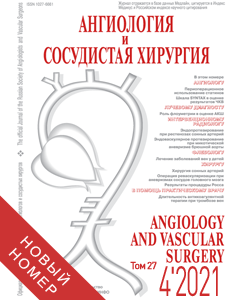Journal «Angiology and Vascular Surgery» •
2016 • VOLUME 22 • №2
Antegrade diastolic blood flow and classic reflux in varicose dilatation of the intersaphenous vein
Shaidakov E.V.1, Rosukhovsky D.A.1,2,3, Grigoryan A.G.1,2, Bulatov V.L.1,2, Ilyukhin E.A.2
1) Institute of Experimental Medicine,
2) Non Governmental Medical Facility Limited Liability Company "Medalp", Saint Petersburg,
3) Non Governmental Medical Facility Limited Liability Company "Axon", Vyborg, Russia
Introduction. In the intersaphenous vein (ISV) there may take place the so-called "antegrade" or "paradoxical" reflux. This type of blood flow is revealed in a series of patients during muscular diastole and is a link of the pathogenesis of varicose disease, but has, as distinct from the "classical" reflux, an antegrade direction. An incompetent saphenopopliteal junction (SPJ) is a source of the antegrade diastolic blood flow (ADBF) through the ISV. Descriptions of possible variants of impaired blood flow through the ISV are fragmentary and their interpretations are controversial. Prevalence and pathogenesis of these disorders impairments have not yet been studied.
Materials and methods. A cross-sectional study: over 4 years three centres examined a total of 1,413 patients diagnosed with class C2–C6 varicose veins according the CEAP classification. All patients underwent ultrasound duplex scanning of lower limb veins. The ADBF was determined as a unidirectional antegrade blood flow with the duration of not more than 0.5 second, observed after the crus was relived of compression (in the diastole). Of the patients included into the study who had no varicose veins on the contralateral extremity with the ISV being spotted we sequentially selected 40 subjects including them into the Study Group for the analysis of blood flow and the diameter of the ISV in health.
Results. Impairments of blood flow in the ISV were revealed in 61 (4.8%) of 1,265 extremities included into the study: the "classical" reflux in 9 (14.8%) limbs, ADBF was revealed in 37 (60.7%) limbs, a combination of the "classical" blood flow and ADBF – in 15 (24.6%) limbs. Hence, the patients were subdivided into three groups.
Studying the nature of blood flow through the ISV in the control group on 40 lower limbs revealed no blood flow disorders. The mean ISV diameter amounted to 1.68 mm (ME=1 mm). The ISV diameter was considerably higher in all studied groups as compared with the control one (p<0.0001). The diameter of the ISV in its proximal portion averagely amounted to 4.48 mm (SD 1.337 mm, SE 0.171 mm). The diameter in the distal portion amounted to 5.39 mm (SD 1.725 mm, SE 0.221 mm).
KEY WORDS: diagnosis of varicose veins, intersaphenous vein, reflux, venous haemodynamics.
P. 108
ARCHIVES MAGAZINE
2021 (Vol.27)
2020 (Vol.26)
2019 (Vol.25)
2018 (Vol.24)
2017 (Vol.23)
2016 (Vol.22)
2015 (Vol.21)
2014 (Vol.20)
2013 (Vol.19)
2012 (Vol.18)
2011 (Vol.17)
2010 (Vol.16)
2009 (Vol.15)
2008 (Vol.14)
2007 (Vol.13)
2006 (Vol.12)
2005 (Vol.11)
2004 (Vol.10)
2001 (Vol.7)
2000 (Vol.6)
1999 (Vol.5)
1998 (Vol.4)
1997 (Vol.3)


